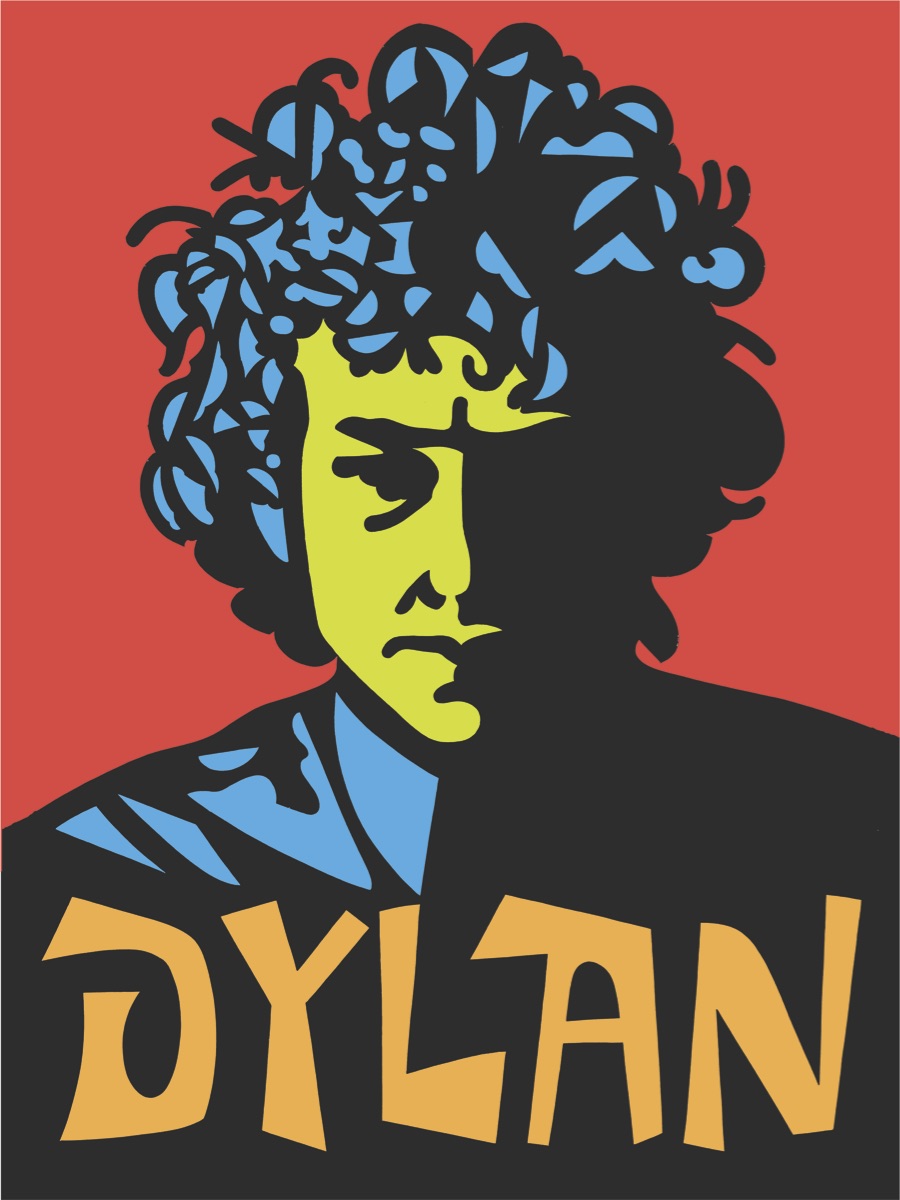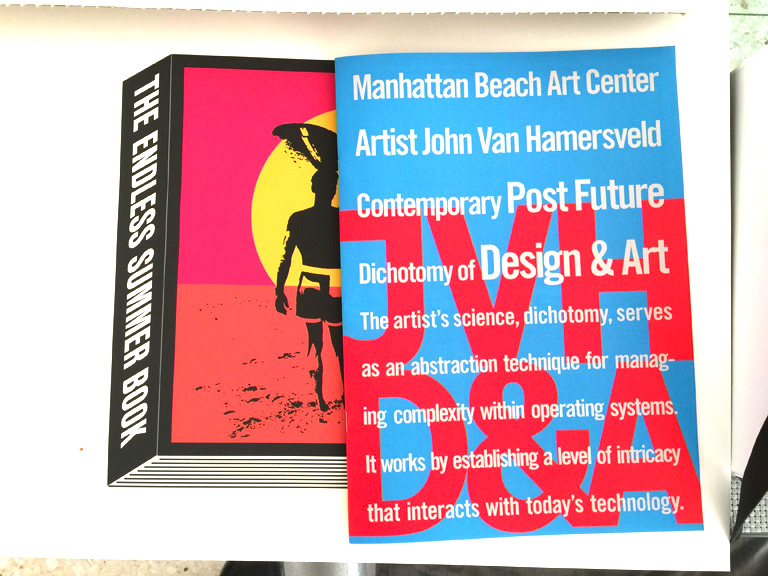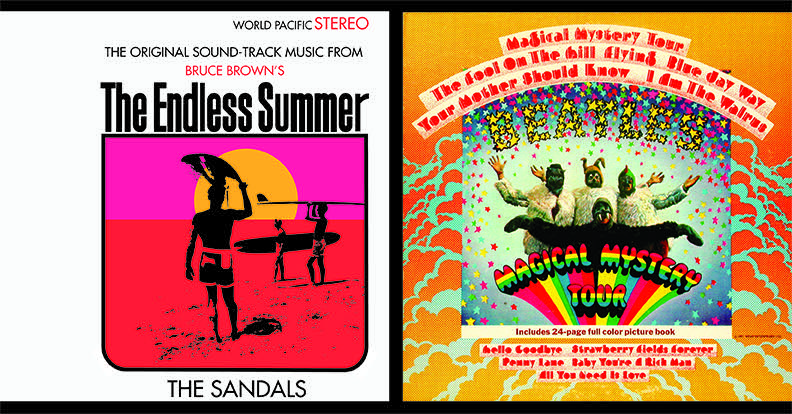John Van Hamersveld retrospective – tonight in Manhattan Beach

The cover of the “Contemporary Post Future” catalogue, with a familiar image peeking out from behind it. Courtesy of John Van Hamersveld
The Hammer comes down in Manhattan Beach
Even if he doesn’t set foot in the water today, John Van Hamersveld will be riding the biggest wave of all. That’s because a tightly-focused retrospective of his work opens in just a few hours, with a reception from 6 to 9 p.m. in the Manhattan Beach Art Center.

“Studio Mascot” (1971), by John Van Hamersveld
One of the most elaborately planned shows to go on display in this venue, the exhibition is crowned, literally crowned, by the installation of a 360-foot frieze designed by Van Hamersveld himself, that encircles the outside of the round gallery.
Comprised of about 36 posters and prints that span a career of over 50 years ( and counting), “Contemporary Post Future: the Dichotomy of Design & Art” is up through Oct. 16, whereas the frieze (simply the Frieze) should remain in place for a year if not longer. As a visual landmark, the Frieze joins several of Van Hamersveld’s public art projects, including the Hermosa Beach mural, some 75-feet long, that graces the North-facing wall on 14th Street, just up from Hermosa Avenue.
He hit the ground running
Let’s not dwell too much on Van Hamersveld’s storied past, about how he grew up in Lunada Bay, VW-vanned it back and forth to El Segundo High School long before the bears were chased off the Peninsula and the first high school built, and how as a young art student he designed a day-glo poster for Bruce Brown’s surfing documentary, “The Endless Summer.” Of course all of this is inescapable, just as any rock band with a Top 40 hit early in its career can never give a concert without playing the song, either as the opening number in order to get it out of the way or as an encore, and thus to send everyone home happy and nostalgic.

John Van Hamersveld at the Manhattan Beach Art Center earlier this week during the installation of “Contemporary Post Future.” Photo
The one thing about an early hit, though, no matter what the medium, is that it does open doors, and in Van Hamersveld’s case the unforeseen popularity of the “Endless Summer” poster definitely helped in the job hunt, which landed the young man at Capitol Records where he designed some 300 album covers — for the Beatles, the Stones, the Airplane, and Blondie, to name a few from the A-list. Not so very long ago I picked up a secondhand copy of Leo Kottke’s “Mudlark” from 1971. Should I have been surprised that, when I opened it, I found that the cover photo had been taken by John Van Hamersveld? I’ll answer that for you. No, I shouldn’t have been surprised at all. For a time, the man was fairly ubiquitous and emerged as an influence on how, then as now, we view the era of the latter 1960s.
We’ve got some explaining to do
So what do you want to know about “Contemporary Post Future: the Dichotomy of Design & Art”? Maybe you want to know about the title. What the heck is post-future and how does it compare with pre-past? Sorry, I’m not much help here, although Van Hamersveld notes that “Google is the referential past and future” and thus it oversees (and perhaps steers) our ‘Contemporary Digital Lifestyle.’”Well, what about the “dichotomy of design & art”? What does that mean?
Okay, now you’ve come to the right person. You see, and don’t share this with anyone else, I wrote a few paragraphs for the catalogue that accompanies the show. I’m going to paraphrase some of it here because it’s actually key to the viewer grasping what the show’s about.
However, Van Hamersveld sums it up quite well at the start of his interview with James Daichendt, which is also in the catalogue. The artist says: “There is a division between personal work and the service work. When you have a job, it’s a service. When you’re working alone it’s not.”
I’ll elaborate. In the design (or commercial) world, a client (usually with deep pockets to match the artist’s empty ones) approaches an artist with a proposition: I need this, this, and that to advertise my shiny new car, and here’s a picture of the vehicle. I’ll pay you X dollars. So the artist looks at the picture, rubs his or her forehead and sweats for a few hours, and then writes some kind of copy or lingo of the “things go better with Coke” variety that leaps off the page when the reader sees it. Conversely, the artist is given a few lines of type and asked to produce an illustration. Same principle. This is essentially the word-image metaphor that Van Hamersveld often talks about. In short, the artist is the server because he or she has put aside a certain amount of self-interest and individuality in order to deliver a product catered to the needs or whim of a client.

A pop culture totem pole created for Fatburger’s edifice complex in order to stand out in a world of cars
That’s the designer. When the same person removes the creative shackles and does a work entirely for his or her self and for kindred spirits, following one’s own muse, as it were, then we’re on the high road to art.
However, what begins merely as a design for a client can skyrocket out of its initial context and become a popular work in its own right. That’s been the case with the “Endless Summer” poster. On its own terms, as an iconic image and a universally recognized symbol of surf culture, it no longer needs the title of the film to explain what it is. It has, very simply, entered the stratosphere of art and pop culture. As proof, the poster is also in New York’s Museum of Modern Art (MoMA).
Emerging from patterns and shapes
Now, going back a few paragraphs, just as certain rock bands end up as one-hit wonders, the same can happen with writers, filmmakers, or visual artists. But with John Van Hamersveld, the hits just kept on coming (his Cream and Jimi Hendrix posters, and his logo for Fatburger, being just three examples).

Installation of the Hermosa Beach Mural, 2015, designed by John Van Hamersveld
He refers to the Manhattan Beach exhibition as a learning room, and here’s how it’s true. In the first gallery we have many of his artworks that were created to promote concerts or surf events or restaurants. That’s to say that the art is paired with something else, often a minimal amount of text. And then there’s the second gallery, where we have the purity of art unencumbered by explanation or wall copy. In this room, the experience and what we make of it is entirely up to each viewer. Both galleries also contain a table with referential material.
What kind of work is it? Well, you won’t mistake any of this for Rembrandt. It’s mostly big, bright, colorful geometric shapes, a kind of pop minimalism, as well as fluid abstract forms, the latter arising out of a series of wave drawings that came to be called “WaterWorks.” It’s all pretty eye-catching stuff, and you may find yourself wondering what the room would be like if they darkened it and turned on a few blacklights.

John Van Hamersveld with “Corbu,” an abstract work that also inspired the Frieze which encircles the crown of the Manhattan Beach Art Center. Photo
Now, what about the Frieze? It’s comprised of 47 panels, each one 36” by 72.” Inspired by the architect Corbusier (Charles-Édouard Jeanneret), “Corbu” is “a geometric attempt to take opposite shapes and then put them together in a composition of figure ground shape.” Although the result also resembles the work of Corbusier’s confrères Amédée Ozenfant and Fernand Léger (the trio mostly associated with the 1920s Purism movement in France), the Frieze additionally references the “hard-edged” style of midcentury West Coast painting. The initial image was then “deconstructed” so that we end up with “a collage of shapes” that create “a visual game of one form juxtaposed with another.”
Looked at another way, though, the reticulated patterns in cream and black may have some people thinking of giraffes and an African motif mixed with hieroglyphics! What it really is, though, is a visual beacon that says, Come in and see this show. Those who step inside should be very pleasantly surprised .
This week John Van Hamersveld turns 75, although with his energy and youthfulness we’d never guess it. What we have then, with this vibrant retrospective, is a birthday gift not only for the artist but a celebration in which everyone can share.
John Van Hamersveld: Contemporary Post Future – The Dichotomy of Design & Art opens tonight with a reception from 6 to 9 p.m. in the Manhattan Beach Art Center, 1560 Manhattan Beach Blvd., Manhattan Beach. Hours, Wednesday through Saturday from 10 a.m. to 9 p.m. and Sunday from 10 a.m. to 5 p.m. Closes Oct. 16. Call (310) 802-5440 or go to citymb.info/exhibition. ER







